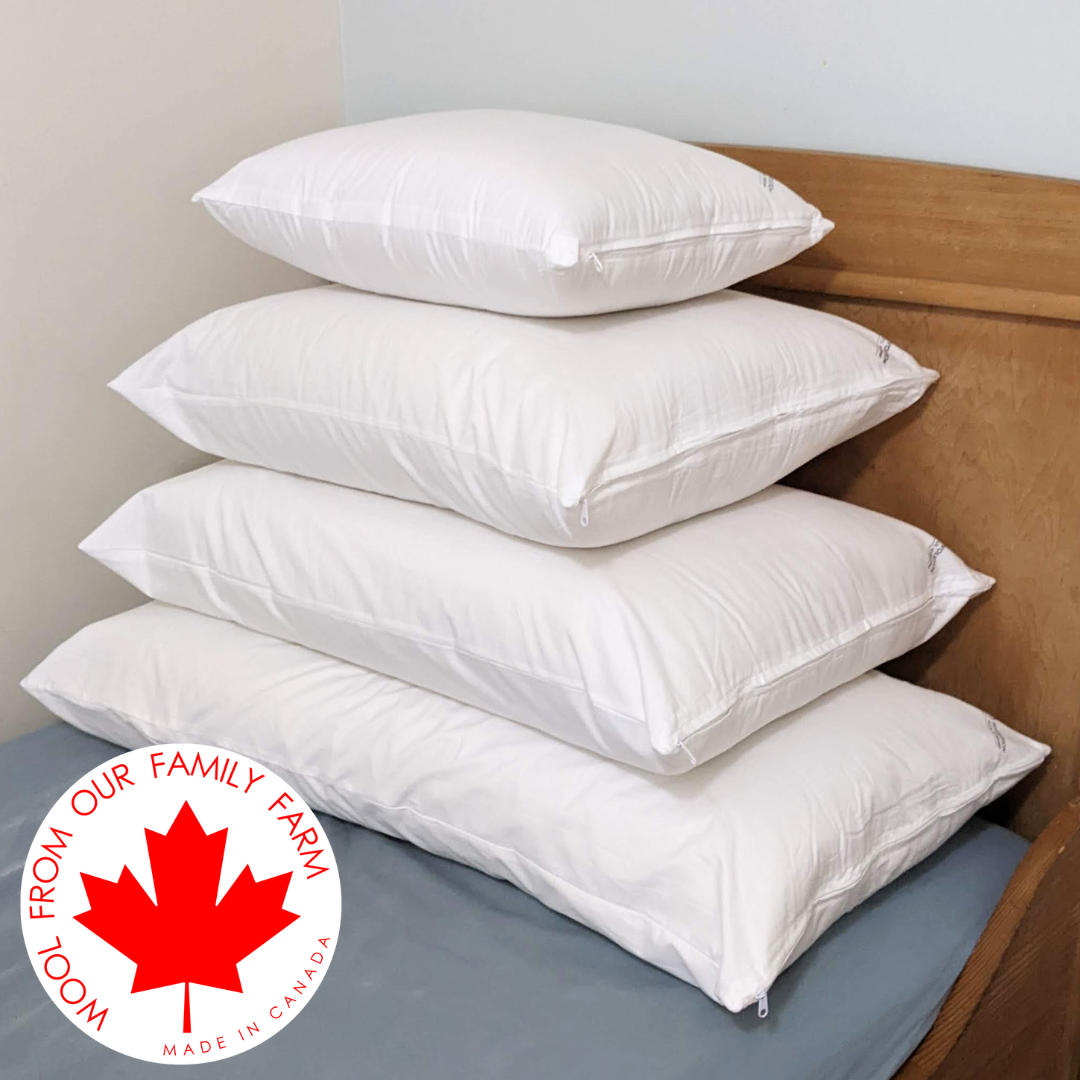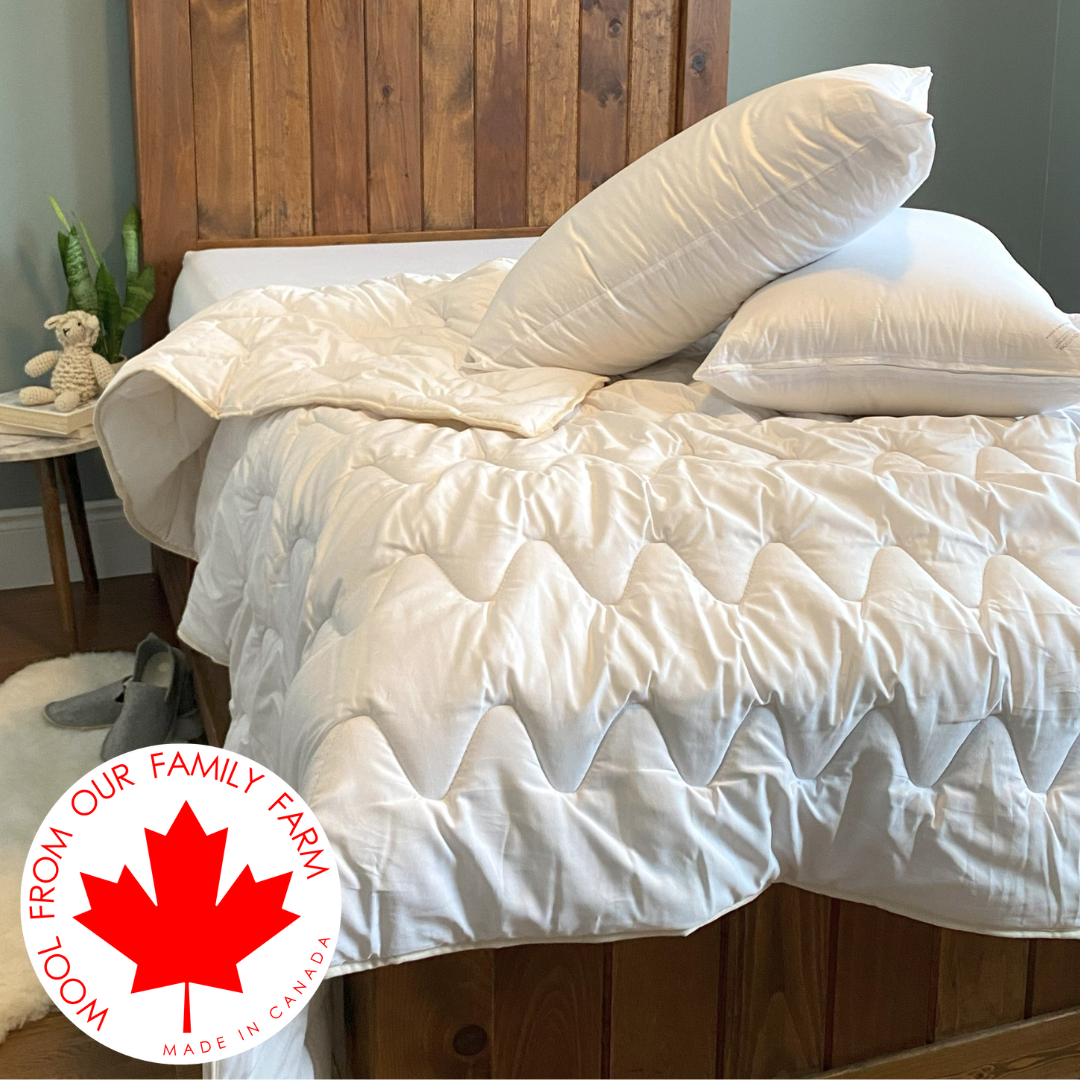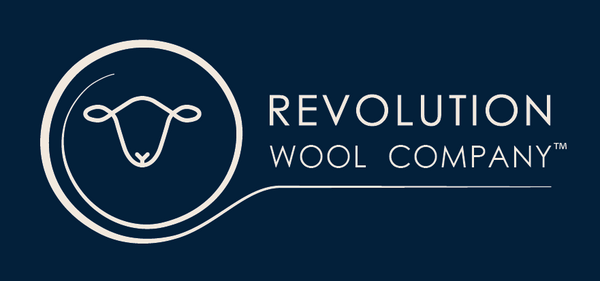Why Choose Wool?

Wool has been used for thousands of years for textiles, clothing, bedding, housing and insulation as humans have worked in connection to sheep and land. Wool is the perfect local fibre to create renewable and sustainable products to support a circular economy and healthy environment. We are a family farm in Ontario, Canada, sell 100% Canadian wool, and work with local Canadian partners, where possible.
Quick facts:
- Regulates body temperature
- Breathable, wicking excess moisture away
- Antibacterial & antimicrobial
- Hypoallergenic
- Resists dust mites
- Resists odours
- Biodegradable
- Easy to care for
-
Naturally cleans the air
About Wool
Natural wool is an amazing, unique, fibre with an incredible physical structure.
The interior of a wool fibre is made up of several different layers that work together to give wool flexibility, elasticity, and resilience, that make it durable and long-lasting. It also makes wool absorbent, moisture-wicking, fire-resistant, and anti-static.
The outer surface of wool is made up of many overlapping cuticles, like shingles on a house. The way these cuticles fall into and overlap with one another is what prevents dirt and dust from reaching the skin. Lanolin is a waxy coating that is produced around each of these cuticles. It inhibits the growth of bacteria and protects the sheep's skin from infection. When we shear sheep, the raw wool gets washed, which takes out excess lanolin. However, we leave some lanolin in the wool so we can still benefit from its fantastic antimicrobial and antibacterial properties.
Why is Wool so Great?
For You
Wool can help regulate body temperature - just like it does on a sheep! This makes it perfect to wear as clothing or use as bedding; ensuring comfort regardless of the season or weather conditions. The fibres in wool allow it to breathe, where synthetic materials can’t and trap heat in. Wool also has the remarkable ability to stimulate soothing and healing receptors in the skin. Many of our customers have shared how sleeping with wool has relieved muscle soreness and arthritis discomfort.
Moisture wicking properties are great for sleeping and anywhere else you use wool. Wool will wick away moisture from your skin, leaving you dryer on warm nights, but still dries quickly. Because of the speed wool wicks away moisture and evaporates, it is also great at removing odours before they start (this is why we love our wool insoles).
Wool is hypoallergenic! The dry environment from the moisture wicking properties makes an undesirable environment for fungus, dust mites, and bacteria.
The impressive structure of wool also makes it fire resistant. It has high ignition temperature and is able to self-extinguish, as it chars and limits oxygen so any fire cannot spread. Its moisture content also helps prevent flames from spreading, making it safer in fire-prone situations.
For Your Community
Utilizing wool products sourced and processed locally not only bolsters our farmers and communities but also upholds rich traditions of textile craftsmanship deeply rooted in our localities. We ensure our farm partners are paid fairly for their quality wools to support their business. By utilizing materials from our farmers and collaborating with skilled artisans and mills, we foster stronger community ties and connections. Supporting local, Canadian, partners is important to us to foster the wool community in Canada. It's particularly gratifying to be acquainted with the farmers and animals behind the wool you cherish!
For the Environment
Wool is both renewable and biodegradable, as sheep continuously produce fleece from the forage they consume. Once sheared, wool follows its own lifecycle, serving various purposes as a product. Eventually, at the end of its lifespan, wool naturally decomposes, returning to the soil. This circular nature of wool production, as well as opting for locally produced goods reducing transportation distances, minimizes waste and pollution. Additionally, wool boasts exceptional durability, with a single garment or product lasting for generations, thus reducing consumption. Utilizing wool clothing or bedding helps conserve water, as wool is naturally self-cleaning and odor-resistant, requiring less frequent washing. Simply allowing your wool items to hang in the fresh air and sunshine is often sufficient to refresh them.
Our Best Rated Wool Products
-

Wool Filled Pillows
Shop the right pillow for youFilled with pure wool batting to offer ideal support for your head and neck, adjustable density 100% Canadian grown and milled.
-

Wool Filled Duvet
Find your clean sleepOur wool duvets are proudly made in Canada right on our farm. They give you a naturally healthier, dryer, and cleaner sleep.
-

Pure Wool Blankets
Get yours hereA quintessential Canadian favourite. Crafted with care, this exceptional blanket offers unparalleled warmth, comfort, and durability.



